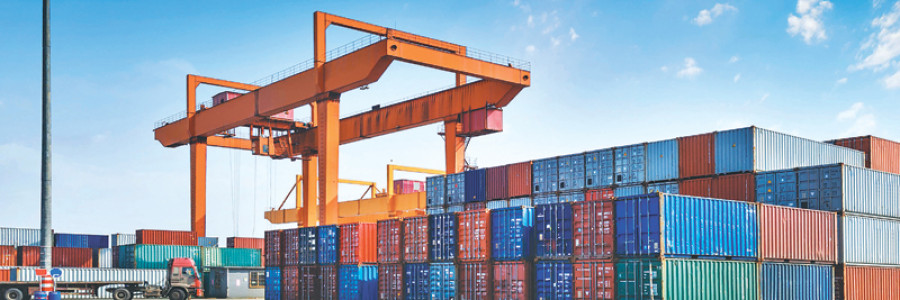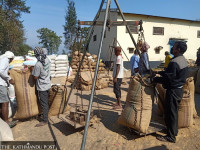Money
Export cash incentive scheme ‘fails’ to meet desired objectives
In December, 40 tonnes of yellow lentils worth over Rs10 million being smuggled from India were intercepted by the police in Parsa.
Rupak D. Sharma
In December, 40 tonnes of yellow lentils worth over Rs10 million being smuggled from India were intercepted by the police in Parsa.
The surprising element in confiscation of the product was self sufficiency achieved by Nepal in lentil production.
Nepal produced 226,830 tonnes of lentils in 2014, becoming the world’s fifth largest country in lentil production, says a November report of the Food and Agriculture Organisation (FAO), a United Nations body.
Lentils produced in Nepal are sufficient for domestic consumption, and surplus can even be and is being exported, according to officials of the Ministry of Agricultural Development.
This clarifies lentils need not be smuggled into the country. Yet this happens, as traders always try to take undue benefit of the government’s export cash incentive scheme.
“Most of the lentil brought into the country from abroad is again exported,” former commerce secretary Purushottam Ojha said. “This way traders earn 2 percent of the value of goods they have exported.”
In other words, lentil exports of Rs10 million could have easily generated Rs200,000 in export cash incentive.
Perhaps because of malpractices like these a draft of a working paper prepared by the World Bank has declared the government’s cash incentive scheme to promote exports a failure in diversifying the range of exportable items and introducing Nepali products in newer foreign markets.
The government introduced Cash Incentive Scheme for Exports through the budget of fiscal year 2010-11, as Nepal’s exports consisted limited number of goods and remained concentrated in a handful of markets.
At the time when the scheme was launched, 85 percent of Nepal’s total exports were absorbed by five countries, with 80 percent of those goods finding a market in India.
Nepal needs to diversify both export products and destinations, as the country’s trade deficit is continuously widening, exerting pressure on the current account.
Hence, introduction of the incentive scheme was considered as a shot in the arm for faltering exports, as it offered cash subsidies ranging from 2 to 4 percent of the export value to all goods with domestic value addition of 30 percent or more. This scheme applied to goods sold in countries other than India.
Yet subsidies could not be extended in the year of announcement of the programme due to delays in preparation of guidelines. It finally came into effect in 2012. However, the scheme was modified in 2013 “partly in response to exporters’ complaints about the complexity of the domestic value-added calculation required to receive subsidies” in the range of 2 to 4 percent.
The revised scheme fixed cash incentive at 2 percent of the export value of goods with domestic value addition of 30 percent or more. At that time, the government also said the subsidy would be made available to firms exporting a group of 25 industrial and seven agricultural products, including lentil, that were listed in Nepal Trade Integration Strategy prepared by the Ministry of Commerce in 2010.
Since the introduction of the policy, the number of firms applying for the scheme has gone up significantly.
In 2012, for instance, only 28 out of 878 firms eligible for the scheme received the cash subsidy of $1.6 million in total. In 2013, that amount went up to $1.8 million; and a total of 57 out of 912 firms qualified for the scheme were given cash subsidies. In 2014, the number of firms that received subsidy jumped to 151, (although the number of firms eligible for the scheme stood at 921). These firms received $3.8 million in cash incentive.
“Firms that received the subsidy began selling a wider range of eligible products across more export destinations,” says the draft of the working paper titled ‘Assessing the Effectiveness of Cash Subsidies on Export Performance: Evidence from Nepal’.
Yet size of Nepal’s export shipments did not go up substantially, because product and market diversification took place only at the firm-level [and not across the industry], adds the paper prepared by World Bank economists on the request of the National Planning Commission, the apex body that frames the country’s development plans and policies.
This, according to the paper, could have happened because of the practice of automatically enrolling a firm in the scheme based on past record.
“One of the key innovations introduced in the 2013 reform of scheme was that exporters that had already obtained a domestic value-added assessment for a previous export shipment could use the same documentation to claim the subsidy in the future without having to apply for a new evaluation - a change that sought to lower the administrative costs associated with claiming the incentive,” says the paper, adding, “An alternative hypothesis, of course, is that firms with stronger political connections are also more likely to repeatedly receive the incentives.”
Although products included in the Trade Integration Strategy account for about 40 percent of the country’s total exports, share of these products sold outside India shows a small increase between 2012 and 2014, according to the paper prepared using figures of 2011-2014.

Nepal has been traditionally exporting goods to the US, Germany, Bangladesh, China, the UK, France, Japan and Singapore, apart from India. This has not changed since the introduction of the cash incentive scheme.
Also, there is very little diversification in production of exportable items since the launch of the scheme, as carpets, man-made fibres, edible vegetables, apparels, and hides and skins account for 90 percent of all subsidy payments.
“The move towards product-targeted subsidies shows the government’s commitment to promote products on the basis of Trade Integration Strategy,” says the paper. “This approach, nevertheless, could hinder the scheme’s objective of greater export diversification given a majority of firms producing goods [listed in the Strategy] were selling those products in third countries even before the subsidy scheme came into effect.”
The scheme was originally introduced to promote the manufacturing sector, which could create jobs for masses, and raise exports, Ojha said. “But we could not meet our objective. The programme needs to be revisited.”




 10.12°C Kathmandu
10.12°C Kathmandu













